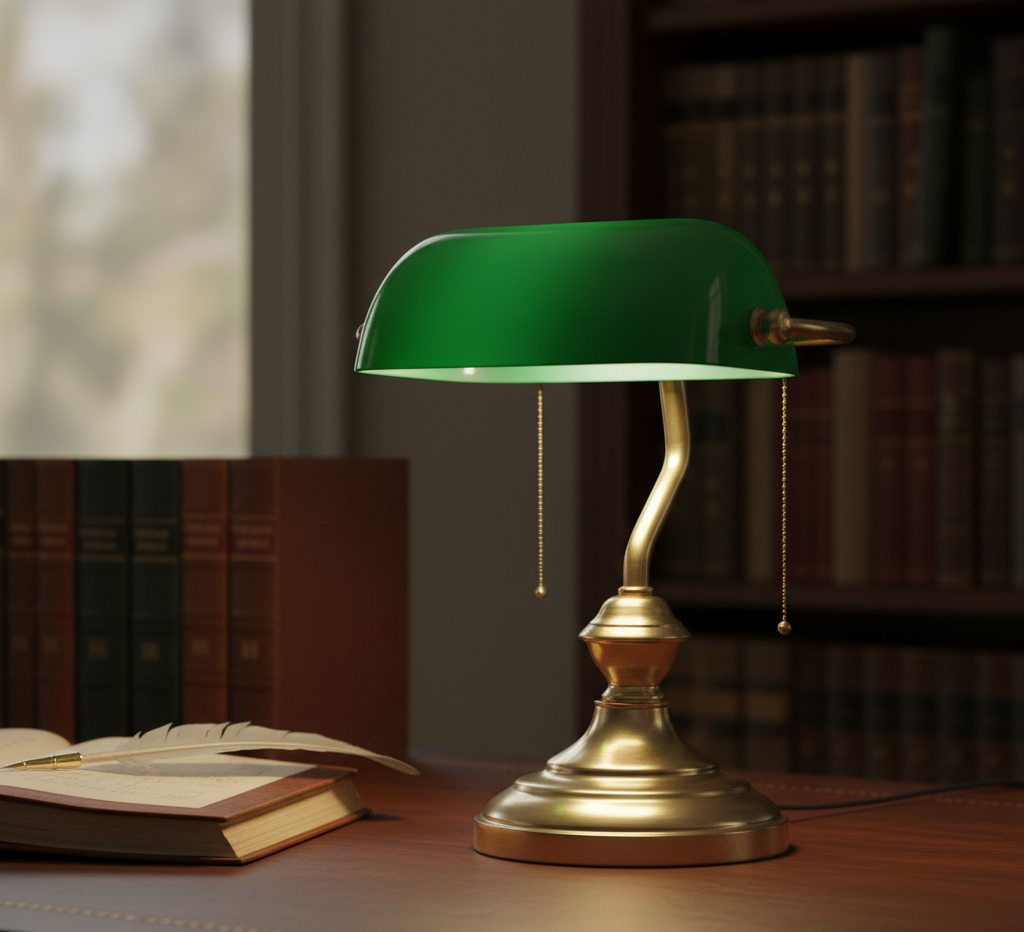Kingsgrove Branch:
Bankers Lamp

If there's one desk lamp that screams "classic" and "sophistication," it's the one with the distinctive green glass shade and brass base. You've seen it in countless old films, libraries, law offices, and even in some swish home studies. But have you ever stopped to wonder, why is it called a Bankers Lamp?
It's not just a fancy name; it’s got a ripper bit of history behind it that cemented its place in design and utility. Let's delve into why this iconic fixture got its legendary moniker.
Back to the Roaring Twenties: The Birth of a Legend
The story of the Bankers Lamp kicks off in the early 20th century, specifically around 1909. An American chap named Harrison D. McFaddin patented the original design, known as the "Emeralite" lamp (a portmanteau of "emerald" and "light").
At this time, electricity was becoming more common, but quality task lighting was still a bit of a luxury. Offices, particularly in the financial sector – banks, accounting firms, and legal chambers – were bustling places. These were environments where intricate paperwork, ledgers, and long hours demanded focused, glare-free illumination.
This is precisely where the Bankers Lamp found its niche.
Designed for the Busy Bloke (or Sheilas) Counting the Pennies
So, why did it become the go-to for bankers?
- Glare Reduction: The most defining feature, that deep green glass shade, wasn't just for looks. It was incredibly practical. Green is known to be a soothing colour for the eyes, especially under artificial light. The heavy, opaque green glass directed all the light downwards onto the desk, preventing glare from hitting the user's eyes directly. This was crucial for reducing eye strain during long hours of poring over documents and numbers. Imagine trying to balance ledgers under a harsh, unshaded bulb – a proper nightmare for the peepers!
- Focused Illumination: The design ensures that the light is concentrated exactly where it's needed – on the workspace. This made it perfect for tasks requiring precision and attention to detail, like counting money, reviewing contracts, or writing endless rows of figures.
- Robust and Sturdy: Early models often featured heavy brass or bronze bases. This wasn't just about aesthetics; it made the lamp incredibly stable and durable. A busy banker or clerk wouldn't want a flimsy lamp toppling over while they were working. This robust construction meant they lasted a lifetime, a good investment for any institution.
- Aesthetic of Authority: Over time, the lamp's presence in these important, authoritative environments – banks, courtrooms, libraries – gave it an air of gravitas and professionalism. It became synonymous with serious work and intellectual pursuits. Seeing one on a desk instantly conveyed an impression of tradition, reliability, and studiousness.
From Bank to Bedroom: An Enduring Icon
While its origins are firmly rooted in the financial world, the Bankers Lamp eventually transcended its initial purpose. Its timeless design, practicality, and aesthetic appeal meant it found its way into homes, studies, and even modern offices. It’s a testament to good design that it remains just as relevant today as it was over a century ago.
So, next time you spot that classic green shade, you'll know it's not just a pretty lamp. It's a piece of history, designed with a clear purpose for the hardworking blokes and sheilas of yesteryear, and it's earned its place as an enduring symbol of focused work and classic style.
Product Source: For a touch of timeless elegance and functional lighting that harkens back to a classic era, explore the range of traditional and modern lighting solutions, including stylish desk lamps, from Schnap Electric Products. They offer quality designs for every space.
Recent posts

Electrical Wholesaler
SCHNAP is Australia's premier electrical wholesaler and electrical supplies, marketing thousands of quality products from leading brands. Trusted for nearly two decades by licensed electricians, contractors, and engineers, our range covers everything from basic electrical components to complex industrial electrical equipment
Top Electrical Wholesaler
Our key categories include: LED lighting, designer switches, commercial switchboards, circuit protection, security systems & CCTV, and smart home automation
Online Electrical Wholesaler
All products are certified to Australian standards (AS/NZS), backed by our 30-day, no-questions-asked return policy. Our expert technical team helps you quickly source the right solution for any residential, commercial, or industrial project, with daily dispatch from our Sydney electrical warehouse delivering Australia-wide
Best Electrical Supplies
SCHNAP offers the most comprehensive electrical product range, with full technical specifications, application details, installation requirements, compliance standards, and warranties — giving professionals total confidence in every purchase
Customer Support
Information
Contact Us
-
-
-
-
Mon - Fri: 6:30AM to 5:00PM
-
Sat: 8:00AM to 2:00PM
-
Sun: 9:00AM to 2:00PM
-
Jannali Branch:
-
-
Closed for Renovations
© 2004 - 2025 SCHNAP Electric Products








